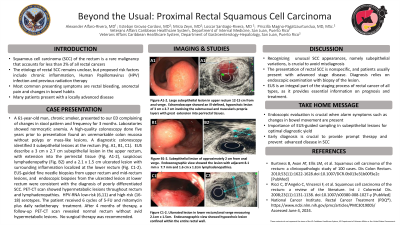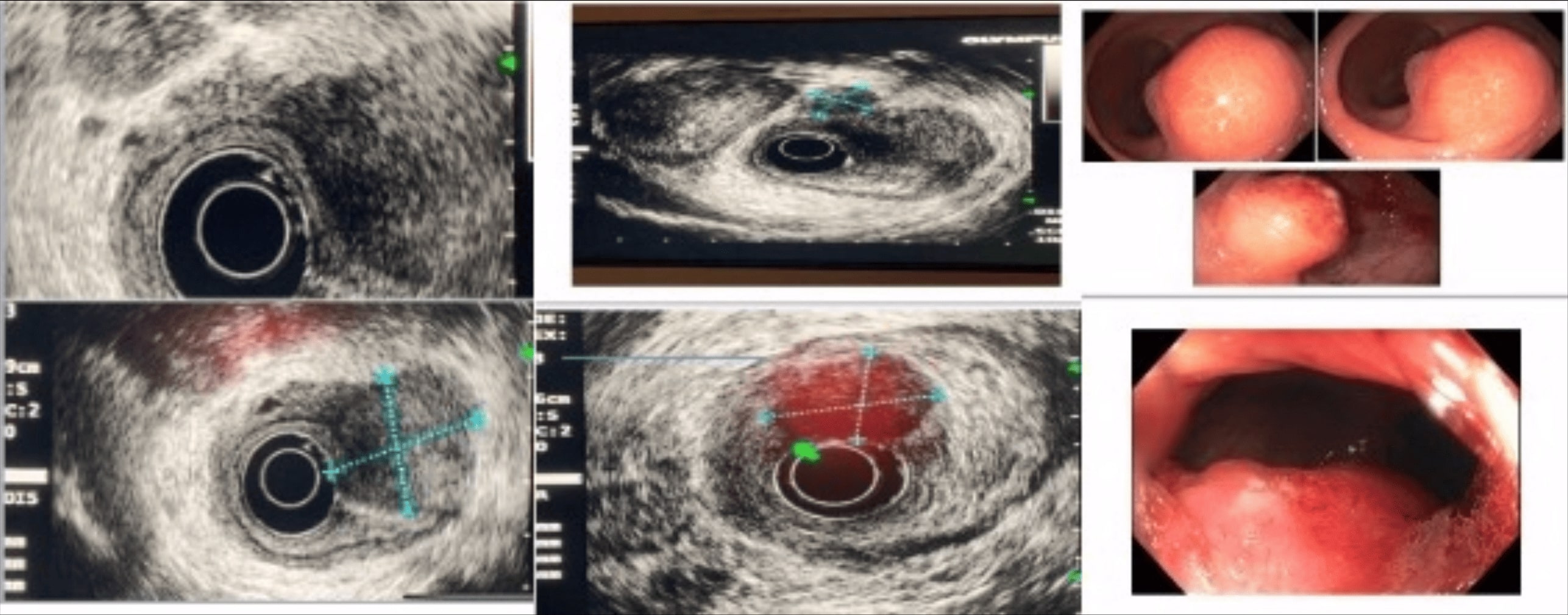Sunday Poster Session
Category: Colorectal Cancer Prevention
P0452 - Beyond the Usual: Upper Rectal Squamous Cell Carcinoma Diagnosed with Retroflexion
Sunday, October 27, 2024
3:30 PM - 7:00 PM ET
Location: Exhibit Hall E

Has Audio

Alexander Alfaro, MD
VA Caribbean Healthcare System
San Juan, PR
Presenting Author(s)
Alexander Rivera Alfaro, MD, Bianca Goyco-Cortes, MD, Esteban Grovas-Cordovi, MD, Mirza Zeyn, MD, Priscilla Magno, MD, Loscar Santiago-Rivera, MD
VA Caribbean Healthcare System, San Juan, Puerto Rico
Introduction: Squamous cell carcinoma (SCC) of the rectum is an exceptionally rare variant, accounting for less than 2% of all rectal cancers [1]. Due to its low prevalence and location lower in the rectum, SCC can be challenging to detect during colonoscopy, with estimates suggesting a detection rate of less than 2 per 1,000 individuals undergoing screening [3]. Risk factors for SCC include chronic inflammation, Human Papillomavirus (HPV) infection, and prior radiation therapy [2]. This case highlights the importance of meticulous attention to detail during colonoscopy, particularly when performing retroflexion of the instrument to fully visualize the rectum. A thorough evaluation of the entire rectal surface is crucial to avoid missing a potential SCC.
Case Description/Methods: A 61-year-old male with hypertension and a current smoker presented with 1-2 month history of changes in bowel habits. Stools were more frequent, non-bloody andpasty.Prior high-quality screening colonoscopy was unremarkable. Diagnostic colonoscopy revealed a large subepithelial mass in the upper rectum. Two additional smaller lesions were found throughout the rectum. EUS confirmed a 3 cm x 2.7 cm proximal rectal lesion with extension into perirectal tissues and suspicious lymph nodes. A distal rectal lesion (2.1 cm x 1.5 cm) was also identified within the rectal wall with surrounding inflammation. Biopsies from both lesions revealed poorly differentiated carcinoma with features most consistent with SCC.
Discussion: This case emphasizes the importance of thorough colonoscopy with retroflexion in the rectum, especially when encountering atypical presentations of SCC. As seen here, SCC can arise in the upper rectum rather than the usual lower location. Additionally, the presence of multiple lesions and a negative prior colonoscopy highlight the potential for SCC to develop even with seemingly normal screening. Therefore, a high index of suspicion and meticulous examination during colonoscopy are crucial for diagnosing SCC, even in patients with atypical bowel habit changes like those presented here (more frequent, non-bloody, pasty stools). Early diagnosis and prompt treatment are crucial for optimal outcomes in these cases [3]. This case also highlights the utility of EUS in further characterizing suspicious lesions and guiding biopsies for further management.

Disclosures:
Alexander Rivera Alfaro, MD, Bianca Goyco-Cortes, MD, Esteban Grovas-Cordovi, MD, Mirza Zeyn, MD, Priscilla Magno, MD, Loscar Santiago-Rivera, MD. P0452 - Beyond the Usual: Upper Rectal Squamous Cell Carcinoma Diagnosed with Retroflexion, ACG 2024 Annual Scientific Meeting Abstracts. Philadelphia, PA: American College of Gastroenterology.
VA Caribbean Healthcare System, San Juan, Puerto Rico
Introduction: Squamous cell carcinoma (SCC) of the rectum is an exceptionally rare variant, accounting for less than 2% of all rectal cancers [1]. Due to its low prevalence and location lower in the rectum, SCC can be challenging to detect during colonoscopy, with estimates suggesting a detection rate of less than 2 per 1,000 individuals undergoing screening [3]. Risk factors for SCC include chronic inflammation, Human Papillomavirus (HPV) infection, and prior radiation therapy [2]. This case highlights the importance of meticulous attention to detail during colonoscopy, particularly when performing retroflexion of the instrument to fully visualize the rectum. A thorough evaluation of the entire rectal surface is crucial to avoid missing a potential SCC.
Case Description/Methods: A 61-year-old male with hypertension and a current smoker presented with 1-2 month history of changes in bowel habits. Stools were more frequent, non-bloody andpasty.Prior high-quality screening colonoscopy was unremarkable. Diagnostic colonoscopy revealed a large subepithelial mass in the upper rectum. Two additional smaller lesions were found throughout the rectum. EUS confirmed a 3 cm x 2.7 cm proximal rectal lesion with extension into perirectal tissues and suspicious lymph nodes. A distal rectal lesion (2.1 cm x 1.5 cm) was also identified within the rectal wall with surrounding inflammation. Biopsies from both lesions revealed poorly differentiated carcinoma with features most consistent with SCC.
Discussion: This case emphasizes the importance of thorough colonoscopy with retroflexion in the rectum, especially when encountering atypical presentations of SCC. As seen here, SCC can arise in the upper rectum rather than the usual lower location. Additionally, the presence of multiple lesions and a negative prior colonoscopy highlight the potential for SCC to develop even with seemingly normal screening. Therefore, a high index of suspicion and meticulous examination during colonoscopy are crucial for diagnosing SCC, even in patients with atypical bowel habit changes like those presented here (more frequent, non-bloody, pasty stools). Early diagnosis and prompt treatment are crucial for optimal outcomes in these cases [3]. This case also highlights the utility of EUS in further characterizing suspicious lesions and guiding biopsies for further management.

Figure: To the left: EUS of anorectal squamous carcinoma. To the right: Subepithelial Squamous Cell Carcinoma
Disclosures:
Alexander Rivera Alfaro indicated no relevant financial relationships.
Bianca Goyco-Cortes indicated no relevant financial relationships.
Esteban Grovas-Cordovi indicated no relevant financial relationships.
Mirza Zeyn indicated no relevant financial relationships.
Priscilla Magno indicated no relevant financial relationships.
Loscar Santiago-Rivera indicated no relevant financial relationships.
Alexander Rivera Alfaro, MD, Bianca Goyco-Cortes, MD, Esteban Grovas-Cordovi, MD, Mirza Zeyn, MD, Priscilla Magno, MD, Loscar Santiago-Rivera, MD. P0452 - Beyond the Usual: Upper Rectal Squamous Cell Carcinoma Diagnosed with Retroflexion, ACG 2024 Annual Scientific Meeting Abstracts. Philadelphia, PA: American College of Gastroenterology.
